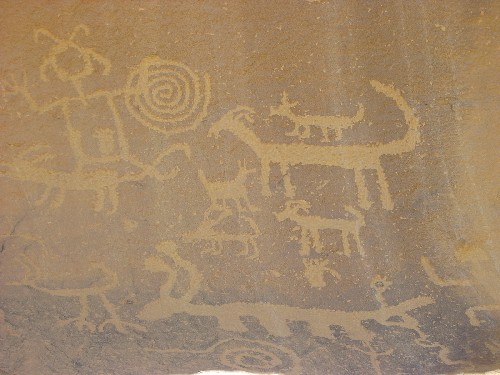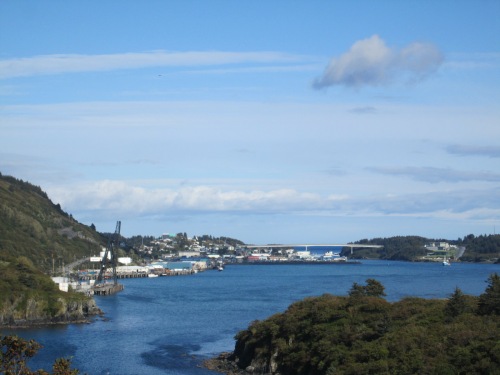
Opening at Casa Rinconada That Channels Sunbeam at Sunrise on Summer Solstice
Today is the summer solstice, so I thought I’d pop back in to do a post about archaeoastronomy, as is my wont. This time it isn’t about the archaeoastronomy of Chaco Canyon per se, but the larger context in which it would have developed, namely that of the civilizations of Mesoamerica to the south.
I’ve mentioned before that I have a tentative theory that part of the impetus for the rise of Chaco as a regional center may have been that its leaders were the first in the Southwest, or at least the northern Southwest, to develop a ritual system based on astronomical observation and alignments, which would have enhanced their ritual authority and consequently their economic and political authority as well. It can be very difficult to date archaeoastronomical phenomena, but it does appear based on my research so far that Chaco does indeed have the earliest datable evidence for astronomical alignments in the northern Southwest, and possibly in the Southwest as a whole. (There is some possible evidence for earlier alignments among the Hohokam of southern Arizona, but it’s somewhat questionable.) This provides some tentative support for the theory.
I don’t think it’s likely that the Chacoan leaders developed their astronomy on their own, though. There is plenty of evidence for contact and communication between them and Mesoamerica, though it isn’t always clear how direct this may have been (as opposed to indirect and mediated through groups in between such as the Hohokam). The much more complex societies of Mesoamerica also had much more elaborate astronomical and calendrical systems than anyone in the Southwest, so they are an obvious source for this as well.
They also presumably developed their knowledge earlier, so as I was thinking about my Chaco theory it occurred to me that it would be good to look into when exactly astronomical alignments and other evidence of this knowledge appear in Mesoamerica and how they spread and changed over time. Basically, the question is whether what is known about the origin and spread of astronomical knowledge in Mesoamerica is consistent with what appears to be true of the origin and spread of similar knowledge further north. Also, it would be helpful to know just how similar the alignments and other phenomena known from Mesoamerica are to those in the Southwest, again to judge the plausibility of a connection.
Luckily for me, an article published last year addressed this exact issue. Written by the Slovenian scholar Ivan Šprajc, it was published in the Journal of Archaeological Research and discusses the temporal and spatial distribution of different building alignments in Mesoamerica. It’s actually a bit odd that this article was published in this journal, which mostly publishes review articles giving a broad overview of recent research on a certain topic in archaeology. Šprajc’s article is in the form of such a review, more or less, but it actually primarily discusses a specific research project done by him and several collaborators, in which they collected very precise and complete data on the alignments of major buildings at many archaeological sites throughout most of the Mesoamerican culture area and analyzed them statistically to come up with general patterns of alignment and see what patterns emerged.
The results were very interesting, especially from an outside perspective. You might expect alignments to the summer and winter solstice sunrises and sunsets to be common, and they were to some extent, but they were by no means the most common. (Alignments to cardinal directions were also present but were even less common.) Much more common, especially in the Maya region, were alignments to certain points on the horizon that do appear to reflect particular sunrises and sunsets, but on different days than the solstices. The specific days cluster in February and October for sunrises and April and August for sunsets. Based on comparisons to ethnohistoric and modern ethnographic accounts of agricultural cycles, Šprajc proposes that these dates marked significant points in the cycle of planting and harvesting cycle, especially for maize, and that marking them would have been part of a very practical system of timekeeping that would also presumably have had ritual importance.
Furthermore, the numbers of days separating many of these dates that pattern together at particular sites tend to reflect multiples of 13 and 20, which are key numbers in the Mesoamerican calendar system, particularly in the 260-day ritual calendar. (Note that 260 is 13 times 20.) Based on the practices of some modern Maya communities that still measure their agricultural cycles this way, it appears that the alignments to mark the key dates would have allowed people to count from those points to figure out the rest of the cycle using these intervals. Since the same dates recur at these intervals in the ritual calendar, which is not calibrated to the solar year, people could have easily used them to keep track of the times for specific activities without worrying about a general calibration.
As a simplified example, if the alignment of a building in a community marked the beginning of the planting season based on the position of the sun, and the community knew that the harvest would come 260 days later, they could take note of the ritual calendar date (number and day-sign) of the beginning day marked by the alignment, the correspondence of which to the solar calendar would vary from year to year, and know that when that date came up again it would be time for harvest. This seems to me like a clever way to deal with the eternal problem of calibrating a solar calendar to seasonal cycles.
Be that as it may, it seems reasonably clear that nothing nearly this elaborate in either calendrical development or architectural alignment was present in the ancient Southwest (though it would be interesting to check some building alignments to see if any of these particular ones show up, which as far as I know no one has done). More interesting to me from my Southwestern perspective is Šprajc’s regional and temporal analysis, which does seem to tentatively provide some support for my Chaco theory.
Šprajc finds, perhaps unsurprisingly, that solstice alignments are the earliest, and that they are particularly characteristic of Preclassic sites in several regions, including Central Mexico, the Olmec region on the Gulf Coast, and the Pacific Coast of Guatemala. What he calls “quarter-day” orientations, which are not strictly to the equinoxes but to the calculated points in between the solstice alignments, are also common in early sites and often associated with solstice alignments. (He is dubious that actual equinox alignments really existed because they are difficult to observe.) In contrast, these alignments are fairly rare in early Maya sites.
The more complex calendrical alignments also appear fairly early, especially in Oaxaca but also in some Olmec sites as well as some in Central Mexico. It appears to be at Teotihuacan in the Early Classic period where two of the widespread calendrical alignments appear together for the first time, accounting for this major city’s well-known layout featuring two slightly different street grids. The subsequent spread of these alignments may be due in part to influence from Teotihuacan throughout Mesoamerica during the Classic period.
Among the areas of apparent Teotihuacan influence in alignment were northern and western Mesoamerica, which are the areas through which influence would presumably have flowed on its way to the Southwest. Šprajc notes, however, that the pattern of alignments shows a lot more diversity in these areas than elsewhere, with solstice and even cardinal alignments retaining substantial influence, and the northern site of Alta Vista may even have a true equinox alignment. From following the references to the more detailed report, it appears that the northern and western sites in the sample are all relatively late, with none earlier than the Early Classic. This is consistent with a spread of at least solstice alignment concepts, and possibly some other ideas, spreading gradually in this direction from the Mesoamerican heartland, eventually reaching Chaco by its rise in the Early Postclassic.
Finally, a word on the moon. Lunar standstill alignments have been identified at some Chacoan sites, especially Chimney Rock, but are controversial due to their general rarity worldwide. I found it intriguing, therefore, that Šprajc does identify some of these in Mesoamerica, but clustered primarily into specific subregions, especially the northeast coast of the Yucatan Peninsula and the Usumacinta drainage at the western edge of the Maya Lowlands. These alignments seem to be to the major lunar standstill and are associated with solstice alignments, implying that perhaps it was the full moons near the solstices that were primarily observed. They also seem to be associated with worship of a particular moon goddess, which helps to distinguish them from alignments to Venus, which are similar and were present in other subareas. This is way on the other end of Mesoamerica from the part most likely to have influenced the Southwest, so direct influence seems unlikely, but it’s interesting to note.
Overall, this article provides very interesting context for understanding Chaco and the role astronomy may have played in its florescence. Happy solstice!
















